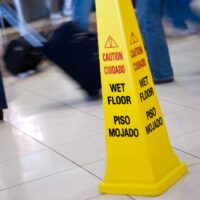How Do You Prove Negligence in a New York Personal Injury Case?

Most personal injury lawsuits are built on the legal theory of negligence. If you’ve been injured in a car crash, a slip and fall, or any other kind of accident caused by someone else’s carelessness, proving negligence is key to obtaining compensation for your injuries.
But what exactly does “negligence” mean in a legal context? And how do you go about proving it in court or during settlement negotiations? At Leandros A. Vrionedes, P.C., we’ve helped countless injury victims in New York understand and establish negligence in personal injury cases. Here’s a breakdown of what goes into proving negligence and what you’ll need to build a strong claim. For personalized advice and representation after an accident or injury in New York City, Nassau or Westchester County, contact our office to speak with a skilled and experienced NYC personal injury lawyer.
What Is Negligence?
In simple terms, negligence occurs when someone fails to act with the level of care that a reasonably prudent person would use in the same situation, and that failure causes harm to another person.
Negligence is not about intentional harm—it’s about carelessness. A driver who texts behind the wheel, a landlord who fails to fix a broken handrail, or a store’s management that ignores a wet floor are all examples of parties who may be considered negligent if their actions (or inactions) lead to someone getting hurt.
To win a personal injury case based on negligence, you need to prove four key elements: duty of care, breach, causation, and damages.
1. Duty of Care
The first step is showing that the defendant owed you a duty of care. This means they had a legal obligation to act in a reasonably safe manner to avoid causing harm.
For example, drivers have a duty to obey traffic laws and drive safely. Property owners have a duty to maintain safe premises for visitors. Doctors have a duty to provide care that meets accepted medical standards. The duty of care exists in many everyday situations, and proving it is usually straightforward.
2. Breach of Duty
Next, you must show that the defendant breached that duty of care. In other words, they acted (or failed to act) in a way that a reasonably prudent person would not have.
This is often the most contested part of a personal injury case. Was the driver speeding or distracted? Did a store fail to clean up a spill in a reasonable time? Did a property owner ignore a clear safety hazard that they knew about or should have known about?
Evidence such as photos, surveillance footage, witness statements, maintenance records, or police reports can help prove that the defendant’s actions were careless or reckless.
3. Causation
Even if the defendant acted negligently, you also have to prove causation—that their negligence directly caused your injuries.
This often involves showing that, if not for the defendant’s actions, you would not have been injured. It also requires ruling out other potential causes. For example, if you slipped on an icy sidewalk, was the fall due to the untreated ice or because you were wearing unsafe footwear?
The causation question sometimes involves complex and technical factual and legal issues. Medical records, expert testimony, and accident reconstruction can help link the negligent behavior to your specific injuries.
4. Damages
Finally, you must prove that you suffered actual harm—physical, emotional, or financial—as a result of the incident. This can include medical expenses, lost income, pain and suffering, and other losses. If you weren’t injured, you don’t have a case, no matter how negligent the other party was.
Proving damages usually involves detailed documentation, such as medical bills, employment records, and expert opinions on how your injuries have affected your life and ability to work.
Common Challenges in Proving Negligence in New York
Negligence might seem straightforward, but personal injury cases often become complex when insurance companies or defense attorneys try to shift blame. They may argue that your injuries were preexisting, that you were partly responsible for the accident, or that their client acted reasonably under the circumstances.
In New York, even if you are found partially at fault, you may still recover damages under the state’s pure comparative negligence rule. However, your compensation will be reduced by your percentage of fault. That’s why having an experienced attorney gather evidence, consult with experts, and present a clear, persuasive case is so important to maximizing the value of your claim and ensuring you aren’t unfairly taken advantage of.
How a New York Personal Injury Lawyer Can Help
Proving negligence requires more than just pointing fingers. It takes a detailed understanding of the law, the ability to gather and preserve critical evidence, and the skill to present that evidence in a compelling way—whether in settlement negotiations or at trial.
At Leandros A. Vrionedes, P.C., we handle every personal injury case with thorough attention and tireless advocacy. We work with medical professionals, accident reconstruction experts, and investigators to build a strong case that proves negligence and maximizes your compensation.
From the initial investigation through trial or settlement, our firm stands by your side every step of the way—so you can focus on healing while we fight for the justice you deserve.
Contact Us for a Free Consultation
If you’ve been injured in an accident in Brooklyn, the Bronx, Queens or Manhattan and believe someone else’s negligence is to blame, don’t wait to take action. Contact Leandros A. Vrionedes, P.C., today for a free consultation. We’ll review your case, explain your rights, and help you understand what it will take to prove negligence and recover the compensation you’re entitled to.
